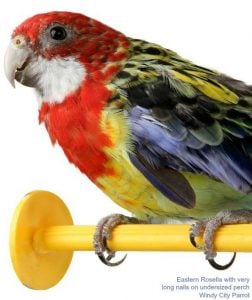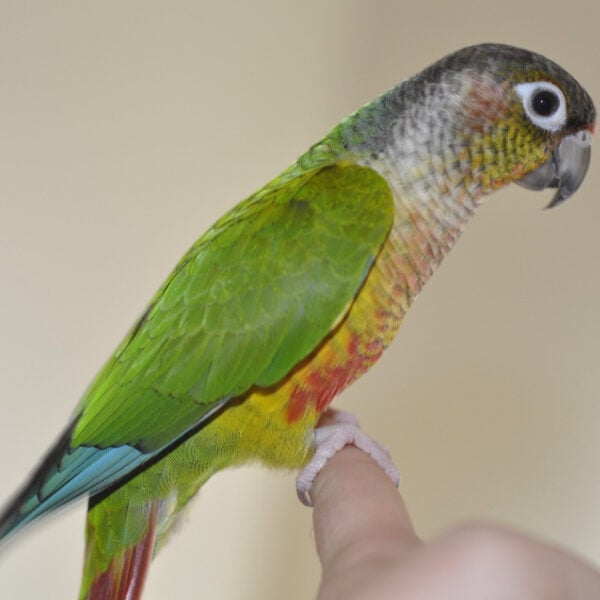
Is Wing Trimming Easy?
Last Updated on by Mitch Rezman
Even birds who never go outside benefit from clipped wings. A fully flighted bird in the house is much more prone to wing, head, and leg injuries resulting from crashes into doors, walls, ceiling fans, windows, mirrors, etc. Sometimes these injuries could prove fatal! Furthermore, an unclipped bird is more likely to act dominantly to its owner, since it knows it can fly away to a high, “superior” spot if it needs to assert itself.
For those feeling pity for stripping our feathered companions of their unique and beautiful flying ability, fear not.
Any bird will learn very quickly to get what it wants using its two wonderfully adapted feet and that marvelous hooked beak (if you don’t believe me, ask Birdmart’s feathered CEOs!).
Think about it this way, in the wild, birds fly (expending lots of time and energy) to find food, shelter, safety, things to play with, places to bathe, and companionship. In a proper human-parrot home, all of these things are provided in abundance.
If let out of the cage often, and offered plenty of opportunity and variety of food, playthings, and companionship, a pet bird with clipped wings will be perfectly content and will never attempt to fly (unless startled).
There are a few different styles of feather clipping. The first ones mentioned are not the ones we recommend! They were designed more for aesthetics and can provide a true false sense of security.
The first is called a Window or Vanity Clip. This means that the two outermost flight feathers (see diagrams below) on both wings are left uncut, and the next 8 or so are cut. It gives a bird a more “wild” appearance. However many birds, especially aerodynamic types like Conures, Macaws, Parakeets, Lovebirds, and Cockatiels, can still fly with this cut! The next common style is the Single Wing Trim.
This is a full cut of only one wing.
With this trim, birds can get lift and propulsion on only one side. As a result, some birds may fly in circles, which could result in severe injury.
Another common trim is an Every Other Feather trim.
In this case, every other flight feather is cut or shaved. This gives the bird a totally wild look, but in many cases does not restrict their flying ability, as a result, it can be very dangerous!
The wing trim recommended by WindyCityParrot.Com is the Bilateral Wing Trim.
With this style, the first 8-10 primary flight feathers on both wings are trimmed to the point of the dorsal major primary covered feathers.
This is a safe cut because you will not hit a blood feather if done correctly. The following diagram describes the method and logic of this trim:
The feathers we are most concerned with when trimming a bird’s wings are the Primary Flight Feathers and secondary Flight Feathers.
The Primary Flight Feathers are the long feathers at the outermost portion of a bird’s wing. They provide forward propulsion. The Secondary Flight Feathers are those feathers between the Primaries and the bird’s body. They provide lift.
When we trim the first 8-10 flight feathers ( on some parrots, like African Grays, only cut the first 6 flight feathers), we are cutting away the primaries.
This takes away the bird’s forward flight propulsion. Without this, the “lift” part of the flight system is fairly useless. So, if the bird tries to fly away, he will flutter safely to the ground, without falling too hard.
When trimming your bird’s wings always aim the scissors away from the bird’s body. Otherwise, serious injury could result.
Also, be sure to have someone competent holding the bird. You could easily get bit or even suffocate your bird if your holder is not careful.
When you cut your bird’s primary flight feathers, use the dorsal major primary coverts as a type of “dotted line” guide.
These are the smaller feathers just above (towards the bird’s head and wrist) the primary flights.
If you cut just below (towards the tail) these feathers, you should never accidentally cut an immature or “blood” feather, which could result in pain and bleeding. Normally, the part of the feather sticking beyond the coverts is mature and without blood supply.
Clipping the wings in this manner can be as painless as cutting hair. Usually, the bird has more objection to the restraint involved than the actual wing trimming.
As shown in the diagram, when the wing is fully extended, we can see the area cut. However, once the wing is pulled back into a folded position, the cut portion folds under the secondary flight feathers and cannot be seen.
On another note, when your bird is first clipped, place it on the floor or the bottom of its cage, so if it decides to “take off”, it will not get much loft and will not go crashing to the floor thus possibly harming itself. It will realize it can’t fly in a short time then.
If in the several months it takes to molt the cut feathers and the new flight feathers have grown back in, the bird shows little interest in flying or behaves itself AND if you have a double door entryway, allowing it to fly again is fine. But if you have only a single door that goes “outside” or the bird gets aggressive/elusive then a fresh clipping is advised.
Author Profile

Latest entries
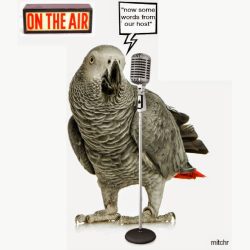 Bird & Parrot CareJune 20, 2025Understanding the Best Way to Use Prevue Pets Mimic Me Voice Trainer
Bird & Parrot CareJune 20, 2025Understanding the Best Way to Use Prevue Pets Mimic Me Voice Trainer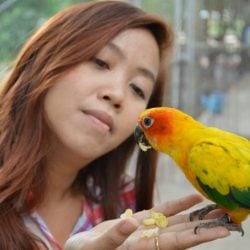 Bird BehaviorJune 6, 2025How Do I Keep My Parrot From Dumping His Food Every Day?
Bird BehaviorJune 6, 2025How Do I Keep My Parrot From Dumping His Food Every Day? Birds & LightingMay 16, 2025I Am Seeking Clarity About Lighting for My Birds Cage
Birds & LightingMay 16, 2025I Am Seeking Clarity About Lighting for My Birds Cage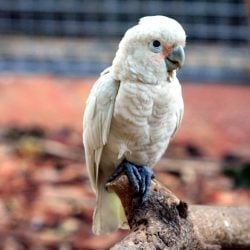 Bird RescueApril 29, 2025How Do We Re-Home a 17 yr Goffin Cockatoo?
Bird RescueApril 29, 2025How Do We Re-Home a 17 yr Goffin Cockatoo?
